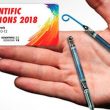Approximately 10% of patients who undergo transcatheter aortic valve replacement (TAVR) are readmitted for an acute coronary syndrome after a mean follow-up of 25 months. Male sex, prior coronary artery disease, and (surprisingly and hard to explain) nontransfemoral approach were independent predictors of acute coronary syndrome after TAVR, an event associated with high midterm mortality. While...
Early Strut Coverage and Its Implications for Dual Antiplatelet Therapy
Optical coherence tomography (OCT)-guided drug-eluting stent implantation improves early strut coverage compared with angiography-guided angioplasty. No difference was observed in terms of strut coverage between permanent-polymer everolimus-eluting stents and bioresorbable-polymer biolimus-eluting stents. Short-term dual antiplatelet therapy may be feasible in selected patients with early strut coverage. This study sought to measure early strut coverage...
Can We Discontinue Betablockers after AMI?
Betablockers (BB) were the first drugs shown to effectively reduce events after acute MI. However, reperfusion and other secondary prevention drugs that came along after that have cast a shadow on betablockers’ original benefit. This study looked at betablocker discontinuation after acute MI in patients with no cardiac failure optimally treated with all recommended medication....
Aspirin, Bleeding and Cardiovascular Events in Healthy Elderly
The ASCEND and ARRIVE trials -presented at the European Cardiology Congress and published in The New England Journal of Medicine (NEJM) and The Lancet respectively- have put against the ropes the indication of aspirin in the context of primary prevention. The ASPREE trial, recently published in the NEJM, appears to have definitely overthrown aspirin, since...
AHA 2018 | More Evidence for the Impella Device, But Larger Trials Are Necessary
In this pilot study, unloading the left ventricle with the Impella CP circulatory support device and delaying angioplasty by about 30 minutes appeared to be feasible and safe in patients with acute myocardial infarction without cardiogenic shock. This work sought to test the hypothesis that the device reduces ischemia-reperfusion injury. The trial included 50 patients who had the...
AHA 2018 | Canakinumab Reduces Hospitalization for Cardiac Failure in Respondents
The benefit was dose-dependent reduction, regardless the presence of absence of baseline cardiac failure. Patients with prior MI and hypersensitivity C-reactive protein (hsCRP) showed dose dependent hospitalization reduction for cardiac failure with the new anti-inflammatory drug Canakinumab, according to this study presented at AHA and simultaneously published in Circulation. The difference between Canakinumab and...
AHA 2018 | Use of Balloon Counterpulsation According to IABP-SHOCK II Trial
Following up on the 30 day and one year effect, the IABP-SHOCK II trial long term outcomes showed there is not benefit to the use of intraaortic balloon counterpulsation in cardiogenic shock patients undergoing acute myocardial infarction. The only work in this group of patients with long term follow up is the SHOCK trial published in...
Cautious Administration of Supplemental 02, Especially in Acute Stroke or MI
Recent studies show the potential damaging effect of supplemental oxygen in the context of acute stroke and myocardial infarction. Experts now say that it should not be used in patients with >92% oxygen saturation. These guidelines have looked into the most recent studies, including the DET02X-AMI, which suggest supplemental oxygen therapy could increase mortality in...
Safety of Combining New Anticoagulant Agents and Dual Antiplatelet Therapy
Atrial fibrillation is the most common arrhythmia and its combination with a history of acute myocardial infarction or coronary angioplasty is quite frequent. According to this study (recently published in JACC), in a real-world population, the combination of direct anticoagulant agents and dual antiplatelet therapy reduces significantly the risk of bleeding and provides similar thromboembolic...
Practical Management of Coronary Perforations
Coronary perforation has an incidence of 0.5% and it is associated with a 13-fold increase in in-hospital events and a 5-fold increase in 30-day mortality. This event is so catastrophic that its management has become indispensable knowledge to all interventional cardiologists. This accident is most frequently provoked by artery over-dilation caused by a balloon or...









